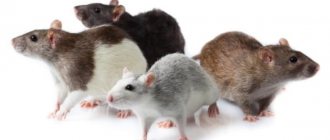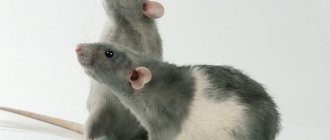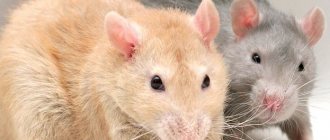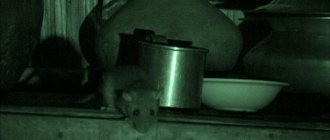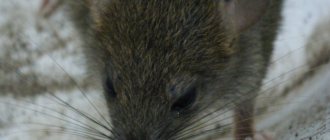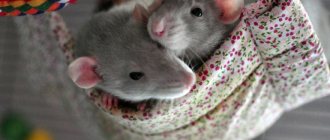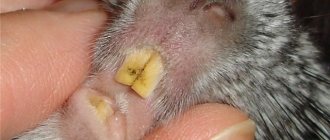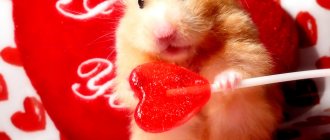A decorative pet rat is a smart animal that will become a true friend for you. With proper upbringing, the animal can learn its name and respond to the owner’s call.
Help: sounds for rats are different from ours. The rat brain “hears” many things differently than a human. Animals love clicking and hissing sounds, so you should choose an appropriate name. If a combination of sounds is unpleasant for decorative rats, then they will simply ignore them.
Preparing to buy a rodent
Cage for rodents Savic Freddy 2
Before you go to a pet store or nursery for a decorative rat, you will need to acquire the necessary equipment. To make your fluffy feel at home in a new place, you need to buy in advance:
- Cage . Small animals are very active, they do not like to sit still and are constantly exploring their surroundings. Therefore, it is better to choose a spacious cage. Preferably multi-tiered so that the pet can run around the floors to its heart's content. To prevent escape, the twigs should be metal, with a maximum distance of 1 cm. And for young animals - 0.8 cm. To easily maintain constant cleanliness in the cage, it is better to choose a model with a plastic tray.
- Filler . Some novice breeders mistakenly believe that it is enough to throw a little shredded toilet paper on the bottom of the cage. But this is the wrong approach - paper litter absorbs liquid well, but does not cope with unwanted odors at all. Therefore, it is better to purchase a more hygienic filler for keeping a rat - sawdust, shavings, corn pellets.
- Feeders and drinkers . Do not pour food directly onto the bottom of the cage. Ready-made formulations, as well as natural food, should be poured into fixed feeders (and into different ones). This way the rat will be accustomed to a certain place for eating. There should be at least 2 drinking bowls in the cage.
- Equipment for warm-up and outdoor games . Rats, if they do not sleep, are constantly on the move. Therefore, it is imperative to install a gaming complex in the cage. It may include a running wheel, bridges, stairs, labyrinths, tunnels, shelves.
- House . Decorative rats sometimes require privacy. For example, when a perceived danger approaches or during a period of illness. Therefore, you will need to buy a special house. It should have 2 entrances and exits and be spacious so that the pet can fit comfortably in it. It is better to choose a structure made of plastic. The material does not absorb odors and is easy to care for.
- Hanging hammocks . Rats love to rest or take a nap. For these purposes, it is worth hanging several cozy fabric hammocks from the ceiling of the cage.
Also, before purchasing a rat, you will need to purchase a special carrier. There are many compact rodent models available on the market now. The main condition when choosing is that the carrier must be made of opaque material and have good ventilation.
Where can I buy a rat?
It’s good if the future owner of a decorative rat has a familiar rat breeder who approaches rodent breeding with responsibility and knowledge of the matter. Otherwise, you will have to go to a specialized organization to purchase a pet:
- Pet Shop . Pet stores are good with low prices. Here you can buy a rat for only 300-500 rubles. However, animals in pet stores are not always kept in accordance with established rules. For example, a couple of weeks after purchasing a female, it may turn out that she is pregnant.
- Bird Market . Pet prices are the lowest here. The average cost of rats is 200-250 rubles. But at the market, sellers often pass off aging animals as young animals. They are also trying to sell outbred rat pups under the guise of purebred rats.
- Online nurseries . The advantage of such organizations is the provision of documents indicating the good health of the rodent, including a vaccination certificate. Disadvantages include online dating through photographs. Prices start from 600 rubles. for a standard rat.
- Professional breeders are ready to vouch for their pets, and also provide the buyer with a full package of documents. It includes a purchase and sale agreement indicating the characteristics of the animal and recommendations for its maintenance, passport, pedigree, veterinary passport. To purchase a decorative rat from a professional breeder you will have to pay from 1.5 to 3 thousand rubles.
Where it is better to buy a pet, everyone decides for themselves. If a novice breeder plans to take a rat to exhibitions and competitions, it is better to give preference to purchasing from a professional breeder. If a fluffy dog is purchased exclusively for the role of a pet, a trusted pet store will do just fine.
How to determine the sex of a baby rat?
Determining the sex of a baby rat
Males and female domestic rats are distinguished, like all animals, by gender. How to determine the sex of a baby rat?
- To do this, you need to hold the rat in your palm with its tail down, carefully holding its head. You can carefully turn the animal onto its back.
- Signs of a male are testicles under the tail, absence of nipples and a significant ( about 6 mm ) distance from the anus to the urethra .
- Females , accordingly, have a double row of mammary glands on the abdomen, no testicles, and the distance from the urethra to the anus is smaller - about 3 mm .
Important : Do not hold a rat by the tail under any circumstances - this is a lot of stress for the animal. Carry out the inspection carefully and carefully.
Which breed is better to choose?
Not many people know that among decorative rats there are several varieties. From a genetic point of view, they may well interbreed. But in appearance they differ noticeably. The most common breeds of decorative rats:
- Standard . Forms the basis of other varieties. The size of an adult male is 22-25 cm, weight - 450-500 g. For a female, similar parameters are 20-22 cm and 350-400 g. They are distinguished by a sharp muzzle and oval or triangular ears.
- Dumbo are the cutest rodents. Their main difference is their large, wide-set ears, like the baby elephant in the cartoon “Dumbo.” Hence the name of the breed. In addition, rats of this variety have a more rounded face and a slightly more compact body size.
- Rex, or curly rat . It has not only curly hair, but also curled short mustaches. The pups have slightly disheveled fur, which gives them a very cute appearance.
- Double rex . In addition to the curly fur, it has another feature - rats of this breed are constantly in the process of molting. Therefore, they always have from 1 to 3 bald areas on their body.
- Fuzz . This species is also called the downy rat. Her body is covered with short, sparse down. The pet feels like it's plush to the touch.
- Sphinx . Like Sphynx cats, rats of this breed are hairless. Some individuals have sparse fluff on the face, paws and in the groin area. Sphynx rats are ideal pets for allergy sufferers.
- Husky . They have a characteristic dark mask on their muzzle, making them very similar to dogs of the same breed. These rats look very original. But over time they lighten, and their characteristic pattern becomes almost invisible.
- Tailless . One of the most expensive breeds. Due to the complete absence of a tail, tailless rats have problems with movement and also suffer from diseases of the genitourinary system.
- Albino - better known as a lab rat. The main feature of this breed is the complete absence of coloring pigment in the body cells. This is why albinos have snow-white fur and red eyes.
In fact, there are many more varieties of decorative rats. Which one to choose is up to the future owner to decide. By the way, it is better to choose a pet not according to breed, but according to your liking.
Growth and development of babies
Little rats grow very quickly. In the first week of life, they gain 3 g of weight every day. Babies actively suck mother's milk, which has high nutritional value. It contains almost 9% protein, the same amount of fat and 4% lactose.
In the first days of their lives, rat pups are constantly near their mother. She moves them from place to place to warm everyone with her body. Small animals do nothing but eat and sleep. On the second day, hungry babies may begin to make a barely audible squeak. Approximately 4 days after birth, the ears of rat pups rise. Now they can hear.
Already on the 4-5th day of life, you can determine what color the little rat pups will have. In light-colored rat pups, the skin remains pink, while in dark-colored pups, it acquires a grayish tint. During this period, the first soft fluff appears on the body.
At the age of one week, baby rats' incisors begin to emerge. The molars will appear no earlier than in 3 weeks. In some individuals they grow only on the 35-40th day of life.
One of the most significant periods in the life of little rats is the time when their eyes open. This occurs 14-17 days after birth. At first a small gap appears between the eyelids, but after a couple of days the babies begin to see.
From this moment on, the little rats become more active and begin to crawl out of the nest. They look around with great curiosity, go around every corner of the cage, learn to wash themselves and clean their fur. By the way, by this time it has already completely grown back. Between the 15th and 20th days of life, females develop nipples.
At 3 weeks of age, the pups look like their adult counterparts. Their body length reaches 14-15 cm, but the tail is still short. At 25 days the animals become completely independent. Females are already capable of becoming pregnant, but this is undesirable, since the body is not yet fully formed and strengthened. The development of rat pups continues until they are one year old.
Who is better to choose, a boy or a girl?
Males and females of the decorative rat are noticeably different from each other. And not only in terms of physiology. The character of pets of opposite sexes also varies greatly. Distinctive features of female rats are:
- Activity . Females are constantly busy with something - playing, practicing on apparatus, grooming.
- Attachment to the owner . Girls are more affectionate. They require constant attention and love to be held and petted.
- Curiosity . Female rats are constantly looking for something, sniffing it, testing it. These little explorers are always ready to discover new horizons.
Boy rats have other characteristic features:
- Laziness . Males prefer a quiet rest in a cozy house or hammock to active games. They, of course, are also not averse to a little frolic, but only sometimes.
- Aggression . Males, especially during puberty, often sort things out with their cage neighbors. This is how they try to strengthen their position in the “pack” and gain the attention of females.
- Gluttony . Boys of decorative rats are ready to eat everything without stopping. The main thing is not to follow their lead and not to overfeed. Otherwise, your pets will experience gastrointestinal upset.
It is also worth noting that if the future owner of decorative rats plans to breed animals, he will need individuals of both sexes. Only, of course, they will have to be kept in different cages.
Many people choose females only because of the very prominent testes of male rats. Some solve this issue by castration.
Features of birth
After the baby is 3–3.5 weeks old, the owner can pick him up. Rodent breeders note that the more often you hold them in your arms, the more affectionate and obedient they will become. The key is to not overdo it. You need to know when to stop everything. Excessive affection is a factor in the development of stress in a pet. You should not separate the mother from the babies for a month. The immune system of newborn rat pups is directly dependent on how long they will be around it.
The total growth period for rat pups is one year. As for nutritional features, after a month you can add cottage cheese, boiled chicken bones, apples, milk corn, and bananas to their diet. There are also a number of foods that should not be included in the diet of baby rats. These are yolk, broccoli, salads, cucumber, liver, tomatoes.
Experts in breeding animals of the rodent family advise adhering to the above recommendations at least until the baby rats reach three months.
The small animal is a defenseless creature that needs special careful care and maternal attention. The attitude of owners towards an animal should be the same as towards their child.
Buy one rat or a pair
Most breeders initially plan to purchase only one rat. After all, with a pet living alone there are fewer problems - it is easier to care for, there will be no conflicts in the cage, minimal consumption of filler and food. However, before drawing such conclusions, it is worth studying a little about the psychology of rodents.
The fact is that rats are social animals. In their natural habitat, they live only in flocks. Therefore, even in captivity, a pet will feel uncomfortable alone. Moreover, living alone for a long time can lead to illness and even death of the rat.
Even if a lonely rat communicates very closely with its owner, this will not save the situation. The little furry needs company around the clock. Therefore, ratologists recommend placing not one, but 2 to 4 rats in one cage at once.
What to look for when choosing a pet
Experienced breeders do not recommend buying the first rat you see. It is better to first look at several options and evaluate the condition of each potential pet. Of course, without veterinary education it will not be possible to identify a disease in an animal. But it is still worth paying attention to certain external signs:
- Conditions of detention . The well-being of a decorative rat largely depends on proper care. If there are too many animals in one cage that are literally sitting on each other's heads, it is better to go shopping elsewhere. This advice is also acceptable if the animal cage has an unbearable stench.
- State of the animal . A healthy rat should be moderately well-fed. Soft shiny fur and the absence of wounds, abrasions and other damage to the skin are also welcome.
- Condition of teeth . The condition of the oral cavity is one of the main indicators of a rat’s health. First of all, you should pay attention to the incisors. They should not be too long (within 1 cm), and the enamel should not be white. Normally, rat teeth are yellow. An unpleasant odor coming from the animal’s mouth should also alert you.
- Behavior . If the rat is lethargic, constantly sits in one place, and looks at one point, there is clearly something wrong with it. Of course, it is possible that the animal simply has a phlegmatic character, but it is better to be safe.
- Pedigree . If the rat is a future participant in various competitions, it is better to get to know its parents and other relatives. Any self-respecting breeder will not refuse this request.
It is also necessary to ask the seller for the relevant documents. A purchase and sale agreement with specified clauses regarding the condition of the animal will serve as a good safety net. Equally important are a health certificate and a vaccination certificate. You can only obtain a passport and pedigree from a professional breeder.
Author block
Pets always bring joy to the home. It is human nature to show care and attention to four-legged friends. Children develop kindness, responsibility, discipline, they learn to care for them, and in return they receive a wonderful friend. Also in adults, the appearance of an animal is always accompanied by positive emotions.
In this article you will learn what criteria to use to choose a pet rat, what are its features, and are there any disadvantages. Get to know the habits of the rodent and its character. Get useful tips on care and maintenance.
Rats are by nature very hardy and intelligent animals. Their intelligence is superior to dogs and cats. They are easy to train and quickly get used to their owner. The domestic rat is easy to care for; even a small child can handle it.
Care and maintenance of rats at home
After purchasing a rat, you need to take care of keeping the animal in proper conditions. To make your pet comfortable in a new place, it is enough to adhere to the following recommendations:
- Place the cage in a room protected from sunlight, high temperatures, drafts and dryness.
- Keep the cage clean. Once every 2-3 days it is necessary to wash the tray and change the filler, and once a month - carry out general cleaning. Drinkers and feeders should be rinsed with boiling water daily.
- Provide your fluffy with proper nutrition. The basis of a balanced menu is made up of ready-made industrial feeds, which must be supplemented with natural nutrition and vitamin-mineral complexes.
- Protect your pet from stress in the form of uninvited guests, noisy companies, aggressive cats and dogs.
The most important thing you need to do for the rodent is to love him and devote as much time as possible to the new family member. And in order for the owner and the pet to get along in character, before buying you should definitely ask how to choose a rat and what you need to know so as not to make a mistake.
Growth rate
Changes in little rat pups are observed daily:
- On the 3rd day the ears appear.
- Teeth appear on days 8-10.
- After 2 weeks, the nipples of females become visible.
- In the third week, the eyes open and the body becomes covered with fur.
The period of childhood in animals is very short, which is confirmed by the following:
- Within 10 days, the pups grow to the size of an adult mouse.
- After a little more than three weeks, the animals begin to feed on their own.
- After 30 days, the cubs leave the parental nest.
Subsequently, the rats grow until the age of 6 months. After this, they gradually mature and reach their maximum size at about a year.

